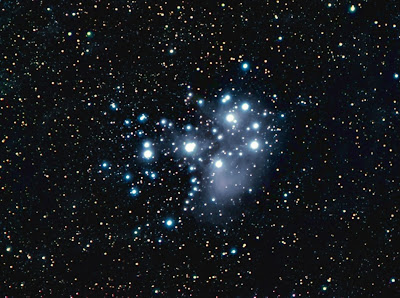Object: IC 410 and IC 405 (The "Flaming Star" Nebula, Caldwell 31)
Despite an ever-increasing haze that cut short my imaging session for this one (hence only 5 blue subs in the end), I was reasonably pleased with the end result. I had planned to take loads more subs if the sky held but given recent history, I was glad I had decided to take a few subs through each filter in turn rather than long sessions through each one.
The channels were stacked in AIP4Win and assigned and aligned in PSP7. The final image was a touch noisy because of the small number of subs, but a quick pass with the freebie version of NeatImage did quite a reasonable job in cleaning it up.
As for the name I gave it, I was just surprised at how sharp the "small 6" of IC410 and "big 9" of IC 405 stood out on the H-alpha frame. The effect isn't quite so striking on the final colour version.
Maybe the final result maybe isn't as good as this one from Greg Parker's New Forest Observatory, but given my somewhat "lower budget" set-up (below), I think I've got value for money on this occasion - especially given the weather...
The shot above (click on the image for a clearer view) shows my current system for wide-field imaging. The equipment is all mounted on a Vixen plate, with the SXV-H9 clamped in a simple bracket made out of a bit of copper tube that I flattened down and drilled. This allows me to rotate the camera for image framing. The filter wheel and lens (with mandatory dew heater) sit on the camera: I've found the filter wheel leaks a bit of light so that's what the silver foil is for. An old Celestron 7 x30 finder is used for rough alignment, with the Vixen guidescope and reticule eyepiece that's above it being used for precise alignments.
It's a simple and robust set-up that stands up quite well to being bounced around on my gadget box when I roll it out of the garage.





